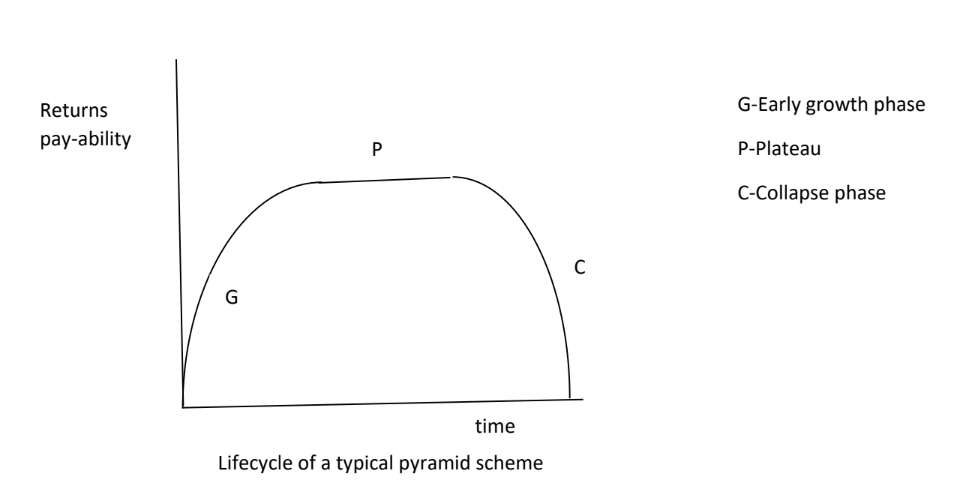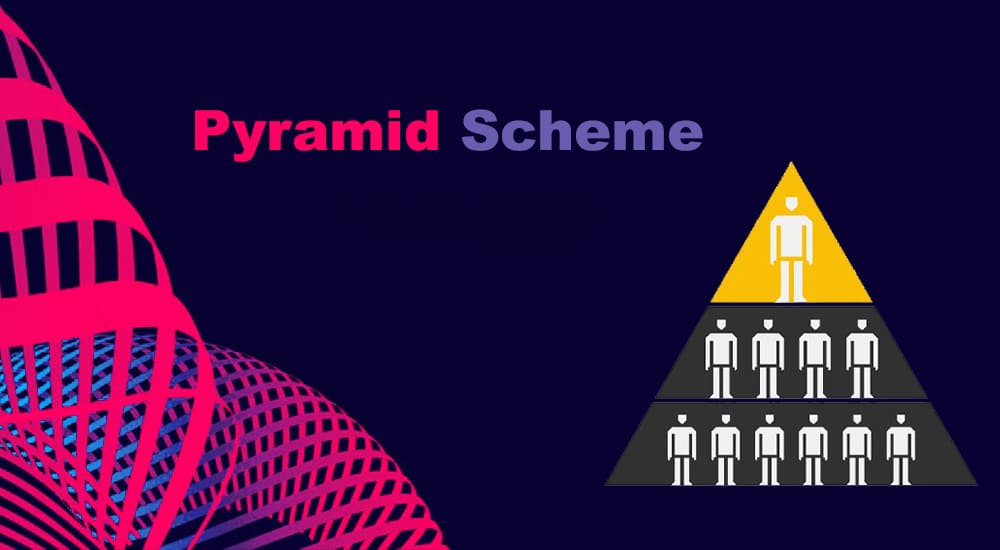There was a connection between the word pyramid and history and tourism. It is unfortunate that in the last century, it has come to be associated with fraudulent activities and schemes. It has nothing to do with its strength and design.
The pyramid scheme is comparable to an artificially constructed hierarchy in which each subsequent tier of membership is introduced by the people who came before them in the chain. It expands much like multi-level marketing, but this expansion is unsustainable and will fail in the end because there is no real and reputable business to back it up.
It appears to be a “nine-day wonder,” which surges ahead during the growth phase until it crashes, and then the company vanishes while investors look for assistance.
What is a Pyramid Scheme?
The investors in the pyramid scheme are promised enormous returns if they can simply recruit more people into the system. These gains are not based on actual investments or the sale of goods or services. Sometimes, to conceal the fact that they are pyramid schemes, these schemes would claim that they sell products to new participants.
The plan kicks off with a promoter inviting the audience to a seminar where the business will be presented for the first time. The speaker asserts that the plan will enable the audience to get wealthy more rapidly, obtain more for the same amount of money spent, earn a passive income, and put their money to work for them.
It only requires a person’s ability to bring people to join the scheme. It is common for recruits to use persuasive methods or one-on-one marketing to persuade their friends and family members to participate in the scheme.
A pyramid scheme may, on occasion, take the form of a job-offering seminar; nevertheless, upon closer inspection, it is revealed to be a pyramid scheme. During the session, they highlighted people who are millionaires as a result of participating in the scheme. The goal of this endeavor is to bring in new members of the organization. The recruits are required to pay a certain fee, which helps pay older recruits.
The growth could be very phenomenal until the business begins to fail. When this issue in sustainability starts, the payment becomes more erratic and less reliable. This is the phase of the collapse.

Pyramid schemes are fraudulent and illegal in many countries. For example, in North Carolina, USA, the law identifies a pyramid scheme as “any plan in which a participant (1) pays money (2) for the chance to receive money (3) upon the introduction of new participants into the program, whether a product or service is offered as well.” Establishing or operating a pyramid scheme is a felony, and someone who promotes or participates can be charged.
How to Recognize a Pyramid Scheme
- No Physical Product: The recruitment of new members, rather than the actual sale of goods, is the primary focus of the pyramid scheme. There is a lot of pressure to increase membership. There is no correlation between the provision of goods and services or financial investments and the generation of sales. It is a plan that uses the new to pay for the old.
- Promises of High Returns in a Short Time: The idea behind the pyramid scheme is that anyone can get wealthy quickly with very little work. Due to the absence of a business model, the audience does not understand it well. In the expansion phase, people are driven by false promises, but they quickly understand that this cannot be maintained. The plan makes payments to older recruits using the initial deposits made by new participants. The plateau phase marks the beginning of the crisis, which occurs when the model fails even with additional participants. During the phase of collapse, individuals become aware of inconsistencies, which may not remain stable for very long before the scheme falls apart.
- No Physical Presence: They may show their presence on the booklet and website, but a quick search can show that it is temporary, virtual, or rented. They don’t have an actual presence with old staff.
How To Avoid Pyramid Schemes
Do the due diligence.
Before joining the bandwagon, research the company.
Do they have a website? Has the physical address been verified? Do they have a real business?
Is the company registered? Are they registered with the Local Chamber of Commerce or Company and Allied Matters Act (CAMA)?
Find and study the company’s track record. Don’t just throw money in because of the news of returns, even with people showing evidence from credit alerts.
Check the company’s history to see how long it has been in operation.
Is the company offering any products or services? It is worth validating even when these are displayed on their web page. Sometimes the rush to make money shifts the attention of unsuspecting prospects from this due diligence. It survives on the urge to make quick money.
NB: Although multi-level marketing (MLM) is predicated on actual product sales, a badly managed MLM has the potential to degenerate into a pyramid scheme if it reaches the point where it can no longer function without continuous recruitment. Pyramid schemes and multi-level marketing (MLM) both focus on recruitment, but MLM places more emphasis on selling a real commodity.
In multi-level marketing (MLM), members are known as marketers, while in pyramid schemes, they are known as canvassers.
The fact that the Ponzi scheme is an investment package should also be emphasized because it is vital. A subscriber puts up some cash and then waits for a substantial return.
A Brief History of the Ponzi Scheme
In December 1919, Charles Ponzi founded a company called Securities Exchange Company, where he promised to double the initial investment of subscribers within 90 days. Within the 90 days, he pooled subscribers and, from the deposits, settled the earlier ones.
This is how the scheme continued until it failed. So, in a Ponzi scheme, after depositing investment, subscribers wait while the organizer pulls more subscriptions. In a pyramid scheme, subscribers bring more recruits after deposit.
Summary
A pyramid scheme is an unsustainable form of company in which participants “recruit” other people to get payments from the deposits they make. There is no retail activity taking on at this location; rather, subscribers bring customers to make deposits. The scheme expands, reaches its pinnacle, and then inevitably falls, and there is very little prospect of gaining control of the pyramid company.
